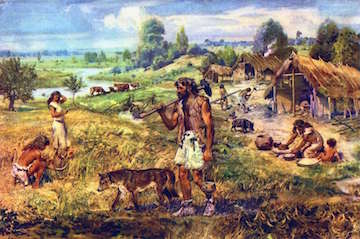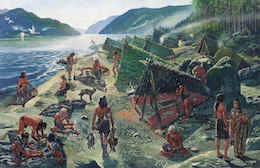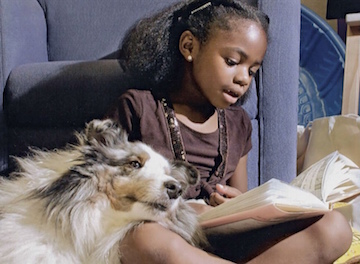Summary | Excerpt | Reviews | Beyond the Book | Read-Alikes | Genres & Themes | Author Bio

Critics' Opinion:
Readers' Opinion:
First Published:
Feb 2018, 224 pages
Paperback:
Feb 2019, 224 pages
 Book Reviewed by:
Book Reviewed by:
Natalie Vaynberg
Buy This Book
This article relates to The Friend
Sigrid Nunez's The Friend reminds us of the power and beauty of the human-canine friendship. Many of us have witnessed the relationship first-hand – our dogs "listen" to us, they comfort us when we are sad and they are the first to greet us when we come home – but where and when did it originate? How did the gray wolf become "man's best friend"?
 Surprisingly, this is a highly contentious question, still raising hackles and stirring up arguments across the global geneticist community.
Surprisingly, this is a highly contentious question, still raising hackles and stirring up arguments across the global geneticist community.
For many years, there were two dominant theories on dog domestication – one is passive, wolves simply came around human encampments to feed off of scraps and stayed around, domesticating themselves. The other theory suggests active domestication – humans chose and cared for wolf pups, training them to stay close and eventually lose their skittishness.
 More recently, a third theory arose – wolves and humans both evolved in a symbiotic relationship, which resulted in the connection we know and love today. Humans followed wolves on the hunt, learning better technique, better routes; yet wolves also understood that humans could be helpful to them, feeding them scraps when prey was thin. There is something familiar about this theory – humans and wolves learned from each other and became better together – isn't this how dog owners might describe their relationship with their pets?
More recently, a third theory arose – wolves and humans both evolved in a symbiotic relationship, which resulted in the connection we know and love today. Humans followed wolves on the hunt, learning better technique, better routes; yet wolves also understood that humans could be helpful to them, feeding them scraps when prey was thin. There is something familiar about this theory – humans and wolves learned from each other and became better together – isn't this how dog owners might describe their relationship with their pets?
 Aside from the details of domestication itself, there is also much debate around when and where this process occurred. While some contend that the earliest domestication could not have been earlier than 14,000 years ago, others suggest it could have been as far back as 33,000. The current controversy on the topic, however, posits that there may have been more than one instance of domestication. It seems that there was once an Ancient Western Dog and an Ancient Eastern Dog. The argument for the Eastern Dog seems fairly secure – fossilized canine DNA in southern China shows the most genetic diversity of any found. However, when the migration of the Eastern Dog was traced to the West, new findings revealed another set of canine DNA, entirely different from the first – dogs had already existed in the West.
Aside from the details of domestication itself, there is also much debate around when and where this process occurred. While some contend that the earliest domestication could not have been earlier than 14,000 years ago, others suggest it could have been as far back as 33,000. The current controversy on the topic, however, posits that there may have been more than one instance of domestication. It seems that there was once an Ancient Western Dog and an Ancient Eastern Dog. The argument for the Eastern Dog seems fairly secure – fossilized canine DNA in southern China shows the most genetic diversity of any found. However, when the migration of the Eastern Dog was traced to the West, new findings revealed another set of canine DNA, entirely different from the first – dogs had already existed in the West.
 Why is this so important? Why is it a topic of debate? Well, for one thing, the relationship between humans and dogs has always been highly fascinating, we love to read about our canine companions and we love to discover more about their origins, their motivations, their thoughts. But more than that, it is important to remember that the dog was the first animal to be domesticated and domestication changed the world. Had humans never domesticated animals, the agricultural revolution – the single most important shift in human history – would never have occurred. So, yes, dogs are "man's best friend", but they were also once the heralds of our unimaginably ambitious future.
Why is this so important? Why is it a topic of debate? Well, for one thing, the relationship between humans and dogs has always been highly fascinating, we love to read about our canine companions and we love to discover more about their origins, their motivations, their thoughts. But more than that, it is important to remember that the dog was the first animal to be domesticated and domestication changed the world. Had humans never domesticated animals, the agricultural revolution – the single most important shift in human history – would never have occurred. So, yes, dogs are "man's best friend", but they were also once the heralds of our unimaginably ambitious future.
Two illustrations of the evolution from wolf to dog, courtesy of www.newtonsapple.org.uk
A combat tracker and his dog
Reading dog, courtesy of B.A.R.K.
Filed under Cultural Curiosities
![]() This "beyond the book article" relates to The Friend. It originally ran in February 2018 and has been updated for the
February 2019 paperback edition.
Go to magazine.
This "beyond the book article" relates to The Friend. It originally ran in February 2018 and has been updated for the
February 2019 paperback edition.
Go to magazine.





The House on Biscayne Bay
by Chanel Cleeton
As death stalks a gothic mansion in Miami, the lives of two women intertwine as the past and present collide.

The Flower Sisters
by Michelle Collins Anderson
From the new Fannie Flagg of the Ozarks, a richly-woven story of family, forgiveness, and reinvention.

The Funeral Cryer by Wenyan Lu
Debut novelist Wenyan Lu brings us this witty yet profound story about one woman's midlife reawakening in contemporary rural China.
Your guide toexceptional books
BookBrowse seeks out and recommends the best in contemporary fiction and nonfiction—books that not only engage and entertain but also deepen our understanding of ourselves and the world around us.